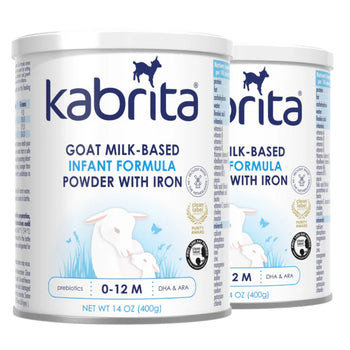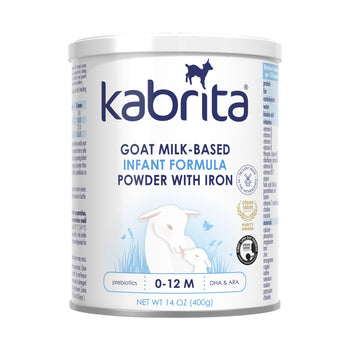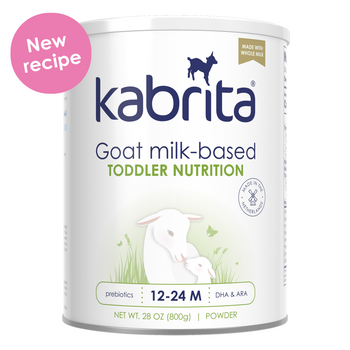Oligosaccharides in Breastmilk and Goat Milk

Information for Health Professionals
Oligosaccharides in breastmilk
Carbohydrates in breastmilk can be broken down into two main groups; lactose, a primary energy source for babies, and oligosaccharides, which are complex carbohydrates that are not digested by babies. There are over 200 known structurally different oligosaccharides found in breastmilk and research is beginning to uncover some of the benefits that oligosaccharides confer on infants and young children.1
Prebiotic properties of oligosaccharides
Studies have shown that oligosaccharides have prebiotic and anti-pathogenic properties. Oligosaccharides provide a food source for gut bacteria and help promote the growth of a diverse range of beneficial bacteria in the gut, paving the way for a healthy gut microbiome.2
Anti-pathogenic properties of oligosaccharides
Research has also shown that oligosaccharides assert an anti-pathogenic benefit by serving as a decoy for pathogens. Many oligosaccharides produce a soluble glycan-like receptor site that some pathogens will bind to in place of binding to the gut lining, ultimately lowering the risk of infection.3
Natural diversity of oligosaccharides in breastmilk
At Kabrita, we believe that the whole is greater than the sum of its parts. This means that the natural diversity of oligosaccharides may confer more benefits to the young child than what can be achieved by one specific oligosaccharide alone. In support of this theory, one recent study found that low diversity in oligosaccharides was associated with an increased risk of developing necrotizing enterocolitis in low birth weight infants.4 We believe that infant formula should model the oligosaccharide diversity naturally present in breastmilk to provide formula-fed infants the health benefits of human milk oligosaccharides. Goat milk contains more diversity in oligosaccharide structure than cow’s milk.5

Number of oligosaccharides in cow vs goat milk
Goat's milk naturally has 4 -10x higher numbers of oligosaccharides compared to cow’s milk. In fact, second only to human milk, goat milk has the highest number of oligosaccharides of any domestic animal.6

Goat milk-based formula, such as Kabrita Goat Milk Toddler Formula, may be more appealing to healthcare practitioners and consumers who want a formula that naturally contains a higher number and more diverse range of oligosaccharides than do some cow milk-based formulas.7
*Goat milk products are not recommended in cases of cow milk protein allergy (CMPA).
1) Ruhaak, L. R., & Lebrilla, C. B. (2012). Analysis and role of oligosaccharides in milk. BMB reports, 45(8), 442–451. https://doi.org/10.5483/BMBRep.2012.45.8.161
2) Lars Bode, Human milk oligosaccharides: Every baby needs a sugar mama, Glycobiology, Volume 22, Issue 9, September 2012, Pages 1147–1162, https://doi.org/10.1093/glycob/cws074
3) Lars Bode, Human milk oligosaccharides: Every baby needs a sugar mama, Glycobiology, Volume 22, Issue 9, September 2012, Pages 1147–1162, https://doi.org/10.1093/glycob/cws074
4) Wejryd, E., Martí, M., Marchini, G., Werme, A., Jonsson, B., Landberg, E., & Abrahamsson, T. R. (2018). Low Diversity of Human Milk Oligosaccharides is Associated with Necrotising Enterocolitis in Extremely Low Birth Weight Infants. Nutrients, 10(10), 1556. https://doi.org/10.3390/nu10101556
5) Kiskini, A., & Difilippo, E. (2013). Oligosaccharides in goat milk: structure, health effects and isolation. Cellular and molecular biology (Noisy-le-Grand, France), 59(1), 25–30.
6) Kiskini, A., & Difilippo, E. (2013). Oligosaccharides in goat milk: structure, health effects and isolation. Cellular and molecular biology (Noisy-le-Grand, France), 59(1), 25–30.
7) Leong, A., Liu, Z., Almshawit, H., Zisu, B., Pillidge, C., Rochfort, S., & Gill, H. (2019). Oligosaccharides in goats’ milk-based infant formula and their prebiotic and anti-infection properties. British Journal of Nutrition, 122(4), 441-449. doi:10.1017/S000711451900134X



